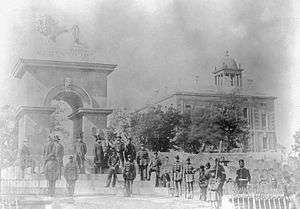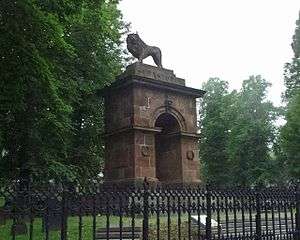George Lang (builder)
George Lang (Laing) (1821 – July 2, 1881) was a stone sculptor, stonemason and builder. He was born in Roxburghshire (now part of Borders), Scotland and died at Shubenacadie, Nova Scotia. In 1858 Lang moved to Halifax, Nova Scotia, where he successfully tendered on principal government and commercial contracts. These works made him one of the leading Halifax builders of the Victorian era.
Early years
Trained in Scotland as a mason, George Lang is said to have worked on the Scott Monument in Edinburgh, erected between 1841 and 1846, and then to have emigrated to St John’s, Newfoundland, to work on the Cathedral of St. John the Baptist (St. John's) constructed between 1847 and 1850. In 1851 Lang and Stirling began operating the Albert Freestone Quarries in Albert County, New Brunswick, where Lang had been a manager until 1858.[1]
Halifax, Nova Scotia

His first building was the Halifax County Court House (present-day Halifax Provincial Court (Spring Garden Road)), designed by William Thomas (architect) of Toronto and erected between 1858 and 1860. The building’s architectural exterior is classic with palladian style that represents stability and strength. Decorative features of the building include use of vermiculation and replete with carvings of the faces of snarling lions and stern, bearded men in each key stone of the original building’s central arches.
Lang’s second commission, a triumphal arch in St Paul’s Cemetery, commemorated British victory in the Crimean War and Halifax’s fallen sons, especially Augustus Frederick Welsford and William B. C. A. Parker. A larger than life twelve ton lion stands atop the Roman triumphal arch. Lang sculpted the lion from Albert County, New Brunswick sandstone.[3] Lang repeated the monument’s lion motif on several later buildings.[1]
Lang also built the present-day Art Gallery of Nova Scotia, which is a three and a half storey, Italianate style building located in the core of downtown Halifax, Nova Scotia. Designed by David Stirling, and built in sandstone, the Art Gallery was built in 1868, modeled after the fifteenth and sixteenth century Italian palazzos built during the Renaissance period. The building is valued today as an excellent example of late nineteenth century Italianate style architecture. The height of the building reduces the buildings proportions, while the triplet composition of the vertical and horizontal divisions and the grouping of the round-arched windows give the building a simple rhythm.[4]
Shubenacadie, Nova Scotia
For his remaining 15 years Lang operated a brick manufactory in Shubenacadie, initially with Halifax carpenter James Thompson.
Another Lang building, and important Nova Scotia architectural landmark, is Convocation Hall at King's Edgehill School in Windsor, Nova Scotia. This Gothic Revival building has played an important part in the lives of students at King's Edgehill (as well at the its predessor institutions of King College and King's College School) serving since its construction in 1867 in the purpose that it was designed for by David Stirling as the campus library. It remains the oldest extant purpose built library in Nova Scotia.[5]
An honorary member of the North British Society from 1858, Lang served as a volunteer in the Chebucto Greys[6] from 1860 to 1865 and as vice-president of the Caledonia Curling Club in 1862.[1]
The Nova Scotia building stones he collected and displayed at the international exhibitions of 1862 (London) and 1865 (Dublin) won him honorary mention at the latter.
Gallery
-
Halifax Provincial Court (inset)
-

Halifax Provincial Court (inset)
-

The Halifax Club, Nova Scotia
-

Halifax Club (inset)
-

Halifax Club (inset)
-

Wellington Barracks, CFB Halifax
-
Art Gallery of Nova Scotia (former Halifax Federal Building) (1868)
-

Art Gallery of Nova Scotia (inset)
-

Art Gallery of Nova Scotia (inset)
-

Alexander Keith's Brewery and Hall
-
.jpg)
Alexander Keith's Brewery and Hall (inset)
-

Convocation Hall, King's Edgehill School (1867)
-
Bust of Queen on Mary, Queen of Scots Inn, Queen St., Halifax
Other works
- Rebuilding Granville Street after the destructive fire of September 1859.
- British Army at Fort Massey 1860–61, the intersection of the present day streets, Queen and South
- St. Luke's Church School House, Queen Street at Morris Street, in Halifax (1862) (architect Henry S. Elliot) (present-day Westminster Apartments)
- Hall and library of King's College, Windsor (present-day King’s Edgehill School)
- Halifax Club, designed by Stirling. 1862–63
- Keith Hall for the brewer and politician, Alexander Keith (1863)
- A group of cottages in Bowery Street
- Quinlan House (1864)
References
Texts
- Susan Buggey. Building in Mid-Nineteenth Century Halifax: The Case of George Lang. Urban History Review 9 no 2 (Oct 1980) 5-20;
- BAIRD, George, and Larry RICHARDS. ”Halifax : Ten Buildings to See.” An article in Trace : A Canadian Review of Architecture, Vol. 1, No. 1, pp 16–24.(Toronto : The Architectural Magazine Society), n.d. [1981]. Pp (2),[1]-[7 2].
- George Lang – Dictionary of Canadian Biography Online
- Harry Piers, “Artists in Nova Scotia,” N.S. Hist. Soc., Coll., 18 (1914): 160.
- “The ‘Welsford–Parker’ monument in Halifax, Nova Scotia,” Soc. for Army Hist. Research, Journal (London), 8 (1929): 129–31.
Endnotes
- 1 2 3 George Lang – Canadian Biography Online
- ↑ Brian Cutherberton identifies Lang as one of the two pair. Harry piers identifies Lang was six feet tall and a beard like Paul (See Piers, Artists of Nova Scotia; Cuthbertson Halifax).
- ↑ Old Burying Ground Foundation, The Restoration of the Old Burying Ground and the Welsford Parker Monument Fundraising Appeal 1988
- ↑ Art Gallery of Nova Scotia - National Historic Site
- ↑ Convocation Hall - National Historic Site
- ↑ For Chebucto Grays see History of the Halifax volunteer battalion and volunteer companies: 1859–1887 By Thomas J. Egan

